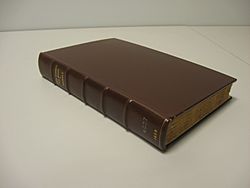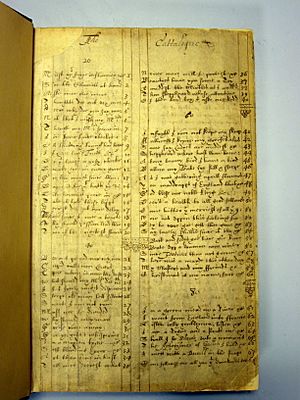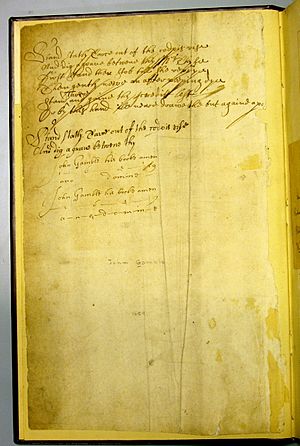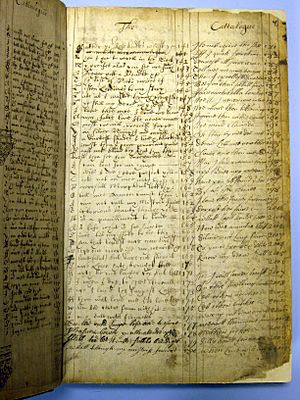Drexel 4257 facts for kids
Quick facts for kids Drexel 4257 |
|
|---|---|
| New York Public Library for the Performing Arts | |
 |
|
| Also known as | John Gamble his booke |
| Type | Commonplace book |
| Date | Uncertain |
| Place of origin | England |
| Language(s) | English |
| Size | 227 leaves |
Drexel 4257 is a special old book filled with music and poems. It's also known as "John Gamble, his booke, amen 1659" because of a note on its first page by a musician named John Gamble. This book is the biggest collection of English songs from the early to mid-1600s.
It's super important for understanding how music changed in England during that time, moving from the older Renaissance music style to the newer Baroque music style. Many songs in the book also talk about what was happening in politics, especially leading up to the time when the king returned to power after a period of war (called the Restoration).
This valuable book is kept at the New York Public Library for the Performing Arts in New York City. Its name, Drexel 4257, comes from its special number in the library's collection.
Contents
Why This Book Is Important
For a long time, people didn't pay much attention to British songs from the 1600s. Some music historians even thought the music wasn't very good. One reason for this might have been that not many British vocal music books were printed back then.
But then, experts started studying Drexel 4257. This book has over 320 songs, and about 250 of them include music! It's the "largest single collection" of early 17th-century English songs we know about.
The composers who wrote these songs were mostly court musicians who worked for the king. Their lives and careers were affected by the English Civil War and the time when England was a republic. Some started their careers with King James I, most worked for King Charles I, and a few even returned to work for King Charles II after the Restoration.
The person who put this collection together (or maybe several people) wasn't just collecting old things. They made this book to be used! It shows what kind of music and poetry people liked in England for about 30 years, from the late Jacobean era to the Restoration period. Even if some of the music isn't perfect, the book is a great snapshot of its time, showing what people were thinking and feeling.
Drexel 4257 is connected to many other old English music books from the 1600s, like Drexel 4041 and Drexel 4175, which are also at the New York Public Library.
What the Book Looks Like
The Drexel 4257 book is about 30 centimeters (12 inches) tall, 20 centimeters (8 inches) wide, and 4.7 centimeters (almost 2 inches) thick. It has 227 pages, called "leaves."
The book was rebound, meaning it got a new cover, on December 6, 1944. The pages aren't numbered, but each song has a number. Experts have different ideas about exactly how many songs are in the book, but it's around 320 to 327. Some songs appear more than once, and some are just titles or lyrics without music.
Out of all the songs, 97 are by known composers. Here are some of them:
- John Gamble (28 songs)
- Henry Lawes (28 songs)
- William Lawes (10 songs)
- John Wilson (11 songs)
- William Webb (8 songs)
- Thomas Brewer (3 songs)
- Robert Smith (2 songs)
- Nicholas Lanier (2 songs)
- Walter Youckney (2 songs)
- Robert Johnson (1 song)
- John Withy (1 song)
- Charles Coleman (1 song)
On the second page of the book, there's a picture of John Gamble from 1795 and a short note about him written by a former owner, Edward F. Rimbault.
The book has two lists of its contents. The first one, called "The Cattalogue," lists songs by number. The second list is in alphabetical order. These lists help us understand how the book was put together.
How Old Is It?
The date "1659" written by John Gamble on one of the first pages has made experts curious. This date is important for figuring out when the book was created.
Researchers look at "watermarks" (designs in the paper that you can see when you hold it up to the light) to help date old books. One watermark in Drexel 4257 was also found in books from 1652 and 1659.
Some experts believe the book was started around the early 1600s, but others disagree because it contains songs by composers like Henry Lawes, who was born in 1596. It's generally thought that the book was mostly finished around 1659, and no new songs were added after the time of the English Commonwealth (before the king returned). Some songs even mention King Charles II, who became king in 1660.
Who Owned This Book?
Experts believe that the later parts of Drexel 4257 were written by John Gamble himself, especially since many of his own songs are in that section. This suggests that someone else started the book, and then John Gamble took it over. One researcher thinks the first writer was a poet named Thomas Jordan.
It's thought that Gamble got the book around 1642–1643, when many court musicians lost their jobs because of the English Civil War. Even though Gamble lost most of his belongings in a big fire in 1666, this book seems to have survived. In his will, written in 1680, he left all his music books to his grandson, who was also named John Gamble.
After John Gamble died in 1687, we don't know who owned the book for over 150 years. The first time it's mentioned in print is in 1846, when it was owned by Edward Francis Rimbault, a musician and collector of rare books.
When Rimbault died, his huge collection was sold at an auction. The Drexel 4257 book was described as having "upwards of 300 songs by Wilson, Lawes, Johnson, Gamble, and other English composers." It was bought by Joseph W. Drexel, a wealthy American who loved music and had a large music library.
Drexel later gave his music library to The Lenox Library. When that library joined with another to become the New York Public Library, Drexel's collection became a very important part of its Music Division. Today, Drexel 4257 is still part of the Drexel Collection at the New York Public Library for the Performing Arts.
How the Songs Are Organized
The songs in Drexel 4257 are sometimes grouped by composer. For example, there are sections with songs by Henry Lawes, William Webb, and John Gamble. There are also three songs written by John Wilson for a play called "The Northern Lass."
The first 47 songs are mostly love poems by famous poets from the Jacobean Court, like Ben Jonson, William Shakespeare, Robert Herrick, and John Suckling.
After song number 47, the book changes. Song number 48, "You madcapps of England that merry will make," suggests a shift towards political topics after 1640. There's a section of 32 ballads and popular songs, which are different from the more artistic songs at the beginning. Later in the book, popular songs and more sophisticated ones are mixed together.
Who Wrote in the Book?
Experts agree that more than one person wrote in Drexel 4257. Some thought there were two main writers, while others, like Elise Bickford Jorgens, believed there were three.
The first writer had a neat, strong handwriting style. The second writer's style was a bit looser and lighter. The third writer's style was rougher and slanted. It's believed that the third writer was probably John Gamble himself, as this hand wrote all of Gamble's songs.
One expert, Lynn Hulse, thinks the first writer might have been the poet Thomas Jordan. She found that Jordan and Gamble knew each other and worked in the same London music and theater circles for many years.
Politics in the Songs
Many songs in the book talk about the politics and events of the time. For example, "Since Itt hath bin lately inacted high Treason" (song no. 313) strongly hints at reactions to British history. Another song, "Beat on, proud billows," was written by Roger L'Estrange when he was in prison during Oliver Cromwell's rule.
Some songs express sadness for a better past. "Listen iolly gentlemen Listen & be merry" (no. 63) praises King Charles I, indirectly criticizing the government that was in power at the time. Another song talks about the problems between King Charles II and his wife, Catherine of Braganza, who was from Portugal. There's also a song that shows a dislike of foreigners, saying that "all ye french... now are all sent back to France."
"You madcaps of England" describes English soldiers at a battle, mentioning real people like "Wentworth" (referring to Thomas Wentworth, 1st Earl of Strafford) and "Murrey" (referring to Robert Moray).
Some songs also show prejudice against Puritans, who were a group of strict Protestants. For example, song no. 92, "Cock Lorrell inuited ye diuell his gestt," connects a known rogue with the devil. However, song no. 70, "The purelings of the Citty," is an exception, praising a Protestant church service.
What Else Are the Songs About?
Besides politics, most songs in Drexel 4257 are about love. They range from fancy, poetic descriptions to more direct stories about love.
A few songs are about other topics. There are two songs about Christmas: "Beate upp a dromm" describes people celebrating, and "Christmas is my name ffar have I gone" is a popular ballad where Christmas itself complains that people have left the countryside for the city and that Protestants and Puritans no longer celebrate it. Similarly, "Ladies you loose yor time" prefers city life over country life.
"Oh yt mine eyes," a song about the Crucifixion of Jesus, is the only religious song in the collection.
One song, "Nor loue nor fate dare I" by John Wilson, is noted as being "composed for the comedy The Northern Lass." Even though this is the only song the book says is from a play, at least 26 songs have lyrics from plays or masques (a type of court entertainment). This shows John Gamble's connection to the theater.
Many of the songs written by Gamble himself are called "drolls." Drolls were often witty and sometimes silly songs, similar to the works of famous writers like Ben Jonson.
Music Style
Drexel 4257 shows how music was changing. It includes older styles, like the "lute song," which was popular during the Renaissance music period. These songs often had smooth, calm melodies.
The book also has newer styles, like the "continuo song," which was part of the Baroque music period. These songs were often more energetic and dramatic. In lute songs, the harmonies (chords) grew out of the melodies, but in continuo songs, the harmonies were more important for the song's structure.
English composers were very good at matching the rhythm of the words in their songs. They also started using more dramatic musical effects, which they learned from Italy. This shows that British composers were interested in new musical ideas.
Many songs in the book are like a recitative (a style of singing that sounds like speaking). Sometimes, the music slows down at the end of a phrase, like a singer taking a breath.
Some songs are in a 6/4 meter (a type of musical rhythm), and some seem to be adapted from violin tunes. The book also contains older songs that were still popular, like "Greensleeves" and "O mistress mine."
Experts have divided the songs into two main styles: the "declamatory air" (the modern style) and the "tuneful air" (the older style). The "tuneful air" could be based on an existing tune or a dance form. The ballads in Drexel 4257 are often clever and satirical, rather than just simple stories.
By 1651, the shift from lute songs to continuo songs was mostly complete. Old music manuscripts like Drexel 4257 are very important because they show us how music was actually performed, including vocal embellishments that might not have been written down in printed versions. This helps us understand how music changed during this exciting time.
Why Drexel 4257 Is So Important
In his research, Vincent Duckles said that John Gamble's main importance comes from putting together this amazing song collection, not so much from his own compositions. Gamble might not have been the best composer, but he was very good at knowing what people liked and how to make a living from music.
Duckles wrote:
There seems to be little doubt but that Gamble's fame will rest upon his work as a compiler of an important song collection, not on his work as a composer. As a musician he was distinctly second-rate, but one can appreciate him as a man with a keen sense of the musical currents (page 138) of his time, an opportunist, who knew what the public wanted and how to turn public taste to his own professional uses... By shrewdness and wit he managed to establish a place for himself in the rough-and-tumble world of mid-17th century music. His songs were soon forgotten, but in his "Commonplace book," compiled without any thought for posterity, he succeeded in presenting one of the most valuable sources we have of the musical taste and musical thought of his time. It is for this reason that an obscure court musician of some 300 years ago remains very much alive in the minds of students of English music history.
Even though Gamble's own songs were forgotten, his "Commonplace book" (Drexel 4257) is a priceless source for understanding the music and tastes of his time. That's why this book, put together by a musician from 300 years ago, is still so important to people who study English music history today.
Copy of the Manuscript
A copy of the manuscript was published in 1987 as Drexel Ms. 4257: John Gamble, "His booke, amen 1659". It's part of a series called English Song, 1600–1675: Facsimiles of Twenty-Six Manuscripts and an Edition of the Texts, volume 10.
See also
- Drexel 4041
- Drexel Collection
Images for kids






